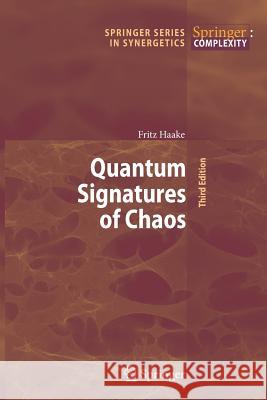Quantum Signatures of Chaos » książka
Quantum Signatures of Chaos
ISBN-13: 9783642263309 / Angielski / Miękka / 2012 / 576 str.
Nine years have passed since I dispatched the second edition, and the book still appears to be in demand. The time may be ripe for an update. As the perhaps most conspicable extension, I describe the understanding of u- versal spectral ?uctuations recently reached on the basis of periodic-orbit theory. To make the presentation of those semiclassical developments selfcontained, I decided to to underpin them by a new short chapter on classical Hamiltonian mechanics. Inasmuch as the semiclassical theory not only draws inspiration from the nonlinear sigma model but actually aims at constructing that model in terms of periodic orbits, it appeared indicated to make small additions to the previous treatment within the chapter on superanalysis. Less voluminous but as close to my heart are additions to the chapter on level dynamics which close previous gaps in that approach to spectral universality. It was a pleasant duty to pay my respect to collegues in our Transregio- Sonderforschungsbereich, Martin Zirnbauer, Alex Altland, Alan Huckleberry, and Peter Heinzner, by including a short account of their beautiful work on nonstandard symmetry classes. The chapter on random matrices has not been expanded in proportion to the development of the ?eld but now includes an up-to-date treatment of an old topic in algebra, Newton's relations, to provide a background to the Riemann-Siegel loo- like of semiclassical periodic-orbit theory.
This by now classic text provides an excellent introduction and survey to the continuously expanding field of quantum chaos . The topics treated include a detailed exploration of the quantum aspects of nonlinear dynamics, quantum criteria to distinguish regular and irregular motion, antiunitary symmetries (generalized time reversal), random matrix theory and a thorough account of the quantum mechanics of dissipative systems. Each chapter is accompanied by a selection of problems which will help the newcomer to test and deepen his/her understanding and to acquire an active command of the methods presented.§In addition to a significant number of smaller revisions and chapter updates, the third edition thoroughly expands on the understanding of universal spectral fluctuations, and to subsequently make the presentation of all semi-classical developments self-contained - a new chapter on classical Hamiltonian chaos has been inserted.§From the reviews of the 2nd edition: In summary, this is definitely an essential reference book for the specialist. It will also ably serve someone entering the field for the first time who needs to learn the theoretical state of the art in detail." (G. Summy ,University of Oxford, Contemporary Physics 2002, vol. 43, p 232)











